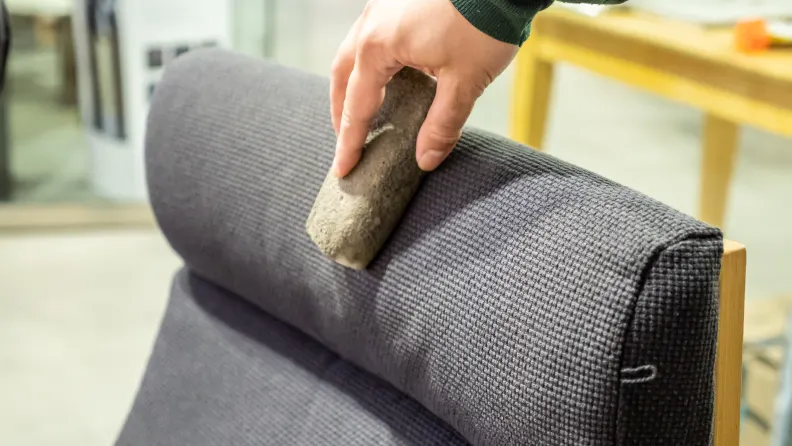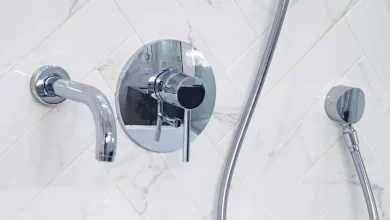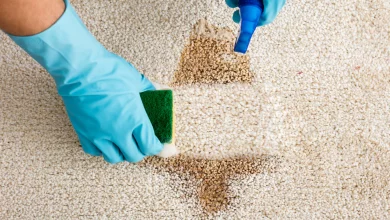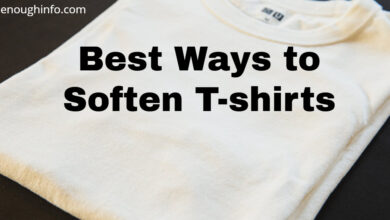How To Remove Pet Hair From Furniture

How to remove pet hair from furniture – Pet hair can quickly gather on furniture, making it appear dirty and unkempt; eliminating pet hair on a regular basis helps maintain cleanliness and improves the overall aesthetic of your furniture. Pet hair contains dander, which can cause allergies and asthma symptoms in sensitive people. By effectively removing pet hair, you can reduce the presence of allergens in your home and create a healthier environment, particularly for family members or guests with allergies. Pet hair can also trap unpleasant odours, especially if your pet spends a lot of time on the furniture. Pet hair removal aids in the removal of odor-causing particles and keeps your furniture smelling fresh. Pet hair on furniture can be a breeding ground for bacteria, dust mites, and other microbes. Regular pet hair removal aids in maintaining adequate cleanliness and decreases the danger of potential health issues. By knowing how to effectively remove pet hair from furniture, you can keep your living space clean and comfortable, reduce allergens, and promote a healthier environment for both you and your pets.enoughinfo
Pets bring joy and companionship to our lives, but their shedding can be a constant battle, especially when it comes to keeping our furniture clean. Pet hair has a knack for finding its way onto upholstery, leaving a trail of frustration for pet owners. However, with the right strategies and techniques, you can effectively remove pet hair from your furniture and maintain a clean and fur-free living space.
Read Also: How To Make Homemade Natural Cleaning Products
Ultimate Guide: How to Remove Pet Hair from Furniture
In this comprehensive guide, we will explore a variety of methods, tools, and preventive measures to tackle pet hair on furniture, ensuring a hair-free and comfortable home environment for both you and your beloved furry friends.
Understanding Pet Hair
- Why Do Pets Shed?
Pet shedding is a natural process that allows animals to get rid of old or damaged hair and regulate their body temperature. The amount and frequency of shedding can vary depending on the breed, season, and individual factors such as diet and health.
- Types of Pet Hair
Pet hair can be short or long, straight or curly, and can range in texture from fine and silky to coarse and wiry. Understanding the characteristics of your pet’s hair will help you choose the most effective methods for removing it from furniture.
- Factors Affecting Shedding
Several factors can influence the amount of shedding your pet experiences. These include breed, age, overall health, hormonal changes (such as pregnancy or nursing in females), stress levels, and seasonal changes. It’s important to consider these factors when developing a strategy to tackle pet hair on furniture.
Preparation and Preventive Measures
- Regular Pet Grooming
One of the best ways to minimize pet hair on furniture is by regularly grooming your pet. Brushing your pet’s coat at least a few times a week helps to remove loose hair and prevent it from ending up on your furniture. Additionally, regular baths can help reduce shedding by keeping your pet’s coat clean and healthy.
- Furniture Covers and Throws
Consider using furniture covers or throws to protect your upholstery from pet hair. These covers can be easily removed and washed, making it simpler to keep your furniture hair-free. Opt for materials that repel pet hair, such as microfiber or leather, or choose covers in patterns or colors that camouflage the hair.
-
Lint Rollers and Sticky Brushes
Keep lint rollers and sticky brushes readily available in your home. These handy tools are quick and effective for removing pet hair from furniture. Roll or brush them over the upholstery to lift and collect the hair. Choose lint rollers with adhesive sheets that can be easily peeled off and replaced when they become full.
Vacuuming Techniques
-
Choosing the Right Vacuum
When it comes to pet hair removal, not all vacuums are created equal. Look for models specifically designed for pet hair with strong suction and specialized attachments. Vacuum cleaners with rotating brushes or beater bars are particularly effective at lifting pet hair from upholstery.
-
Vacuum Attachments for Pet Hair Removal
Utilize the various attachments that come with your vacuum cleaner. The upholstery brush attachment with soft bristles is ideal for gentle but thorough cleaning of fabric surfaces. Crevice tools help to reach tight spaces, and pet hair-specific attachments, like rubberized brushes or rubber blades, work wonders for removing embedded hair.
-
Effective Vacuuming Tips
Before vacuuming, use a brush or a gloved hand to loosen and agitate the pet hair on furniture. This makes it easier for the vacuum to pick up the hair. Vacuum in multiple directions, making overlapping passes to ensure all the hair is captured. Empty the vacuum canister or change the bag regularly to maintain optimal suction.
Read Also: How to make homemade body scrub
Utilizing Lint Rollers and Tape
-
Lint Rollers:
A Pet Owner’s Best Friend Lint rollers are excellent tools for removing pet hair from furniture quickly. Simply roll the sticky tape over the upholstery, applying moderate pressure to lift the hair. When the tape is full, tear it off and continue until you’ve removed all the pet hair. Keep a lint roller near your furniture for convenient touch-ups.
-
Duct Tape and Masking Tape Tricks
In the absence of a lint roller, duct tape or masking tape can be used as effective alternatives. Wrap a piece of tape around your hand with the sticky side facing out, then press it onto the furniture and lift it off. The hair will adhere to the tape, and you can continue using fresh sections of tape until you’ve removed all the pet hair. This method is particularly useful for hard-to-reach corners and crevices.
-
Creative Use of Sticky Brushes
Another option is to use a sticky brush specifically designed for pet hair removal. These brushes have sticky surfaces that attract and lift pet hair from furniture. Simply brush the surface in a sweeping motion, and the hair will adhere to the brush. Rinse or wipe off the brush when it becomes covered in hair, and continue until you’ve achieved the desired results.
The Power of Rubber
-
Rubber Gloves for Pet Hair Removal
Rubber gloves can work wonders in removing pet hair from furniture. Put on a pair of gloves and slightly dampen them. Rub your gloved hands over the furniture in a sweeping motion. The hair will cling to the gloves due to static electricity. Rinse off the gloves when they become covered in hair, and repeat until you’ve removed most of the pet hair.
-
Rubber Brooms and Squeegees
Rubber brooms and squeegees are effective tools for removing pet hair from furniture, particularly from fabric surfaces. Use the rubber bristles of a broom or the rubber edge of a squeegee to create friction and static electricity, which will attract and lift the pet hair. Simply brush or swipe the surface in a downward motion, collecting the hair as you go.
Upholstery Cleaning Sprays
-
Homemade Fabric Softener Spray
Create a DIY fabric softener spray by diluting fabric softener with water in a spray bottle. Lightly mist the mixture over your furniture, allowing it to penetrate the fabric. The fabric softener helps to loosen the pet hair, making it easier to remove with a brush, vacuum, or lint roller. Test the spray on a small, inconspicuous area first to ensure it doesn’t cause any damage or discoloration.
-
Commercial Upholstery Cleaning Sprays
There are also commercial upholstery cleaning sprays available specifically formulated to remove pet hair. These sprays typically contain anti-static properties and are designed to loosen and lift pet hair from furniture. Follow the instructions on the product label for optimal results and use caution when applying on delicate or sensitive fabrics.
-
Applying and Removing the Spray
When using upholstery cleaning sprays, it’s important to apply them evenly and in moderation. Avoid saturating the fabric, as excessive moisture can lead to mold or damage. Allow the spray to sit for a few minutes to work its magic, then use a brush, vacuum, or lint roller to remove the loosened hair. Repeat the process as necessary until the pet hair is fully removed.
Read Also: How to clean a microwave(The Ultimate Guide )
Brushing Techniques
-
Choosing the Right Brush
Selecting the appropriate brush for your furniture and the type of pet hair is crucial. For fabric upholstery, opt for a brush with soft bristles or rubberized nubs that can penetrate the fibers without causing damage. For leather or vinyl upholstery, use a soft-bristle brush or a microfiber cloth to avoid scratching the surface.
-
Dry and Damp Brushing Methods
Dry brushing involves using a brush to remove loose pet hair from furniture without any additional products. Simply brush the surface in long, sweeping motions, applying gentle pressure to lift the hair. Damp brushing, on the other hand, involves lightly misting the furniture with water or a fabric-safe cleaning solution and then brushing. The dampness helps to weigh down the hair, making it easier to remove. Be cautious when using damp brushing on delicate or water-sensitive fabrics and always test on a small, inconspicuous area first.
-
Brushing Techniques for Different Fabrics
Different fabrics require different brushing techniques. For fabric upholstery, use long, sweeping motions with the brush, following the direction of the fabric’s weave. This helps to loosen and lift the hair effectively. For leather or vinyl upholstery, use gentle circular motions with a soft-bristle brush or a microfiber cloth to avoid scratching the surface.
Natural and DIY Solutions
-
A velour brush or a pumice stone
This can be effective in removing pet hair from certain types of fabric upholstery. Rub the velour brush or pumice stone gently across the fabric in one direction to lift the hair. The rough texture of the stone or brush helps to dislodge the hair, making it easier to remove.
-
Balloons and Static Electricity
Harness the power of static electricity by rubbing a blown-up balloon or an inflated rubber glove over the furniture. The static charge attracts the pet hair, causing it to stick to the balloon or glove. Repeat this process until you’ve removed the majority of the hair.
-
Vinegar and Baking Soda Remedies
Create a mixture of equal parts water and white vinegar or sprinkle baking soda over the furniture. Allow it to sit for a few minutes to help loosen the pet hair. Then, use a brush, vacuum, or lint roller to remove the hair along with the vinegar or baking soda residue. These remedies can also help neutralize any odors associated with pet hair.
Professional Help and Maintenance
-
Seeking Professional Upholstery Cleaning
If your furniture is heavily covered in pet hair or requires a deep cleaning, consider hiring professional upholstery cleaning services. These professionals have the expertise and specialized equipment to effectively remove pet hair and deep-seated dirt from your furniture, leaving it fresh and revitalized.
-
Regular Maintenance and Cleaning Routine
Prevention is key to managing pet hair on furniture. Establish a regular maintenance and cleaning routine that includes brushing your pet, vacuuming your furniture, and utilizing the various techniques mentioned in this guide. By staying proactive and consistent, you can minimize the amount of pet hair that accumulates on your furniture.
Read Also: How to clean silver jewelry at home
Basic Methods For Removing Pet Hair From Furniture
Removing pet hair from furniture can be a challenge, but with the right techniques, you can effectively clean your furniture. Here are some basic methods to remove pet hair from furniture:
- Vacuuming: Use a vacuum cleaner with a brush attachment or a specialized pet hair attachment. Run the attachment over the furniture in a systematic manner, covering all areas. Move the attachment in different directions to loosen and pick up the pet hair effectively.
- Lint rollers: Lint rollers are adhesive tape rollers designed to pick up hair and lint. Roll the sticky tape over your furniture, applying moderate pressure. When the tape becomes full of hair, tear it off and continue until you have removed all the pet hair.
- Rubber gloves: Put on a pair of rubber gloves and slightly dampen them. Rub your gloved hands over the furniture in a sweeping motion. The hair will cling to the gloves due to static electricity. Rinse off the gloves when they become covered in hair, and repeat until you’ve removed most of the pet hair.
- Duct tape: Wrap a piece of duct tape around your hand with the sticky side facing out. Gently press the tape onto the furniture and then lift it off. The hair will stick to the tape, and you can continue using fresh sections of tape until you’ve removed all the pet hair.
- Fabric softener spray: Dilute fabric softener with water in a spray bottle, and lightly mist your furniture. The fabric softener will help loosen the pet hair, making it easier to remove with a brush or vacuum.
- Brushing: Use a stiff-bristle brush or a pet hair removal brush specifically designed for furniture. Brush the furniture vigorously to dislodge the hair, and then vacuum or use a lint roller to pick up the loosened hair.
Remember to test any cleaning method on a small, inconspicuous area of your furniture first to ensure it doesn’t cause any damage or discoloration. Regular maintenance, such as brushing your pet and using furniture covers, can also help reduce the amount of pet hair on your furniture.
Frequently Asked Questions (FAQs):
Can I use a regular vacuum cleaner to remove pet hair from furniture?
Yes, you can use a regular vacuum cleaner for pet hair removal. However, it’s recommended to choose a vacuum cleaner with strong suction and specialized attachments designed for pet hair. These attachments, such as upholstery brushes and rubberized tools, are more effective at lifting pet hair from furniture.
How often should I groom my pet to reduce shedding?
The frequency of grooming depends on the breed and individual needs of your pet. In general, regular brushing a few times a week helps to remove loose hair and reduce shedding. However, some breeds may require more frequent grooming, especially those with longer or thicker coats.
Are there any specific techniques for removing pet hair from leather furniture?
When removing pet hair from leather furniture, use a soft-bristle brush or a microfiber cloth to avoid scratching the surface. Gently brush or wipe the furniture in circular motions to lift the hair. You can also use a slightly damp cloth to help trap the hair.How to remove pet hair from furniture
How can I prevent pet hair from accumulating on furniture in the first place?
To prevent pet hair from accumulating on furniture, consider using furniture covers or throws that can be easily removed and washed. Regularly grooming your pet helps to minimize shedding. Additionally, creating designated pet-friendly areas with blankets or beds can encourage your pet to stay off the furniture.
Are there any natural alternatives to commercial upholstery cleaning sprays?
Yes, there are natural alternatives you can try. For example, a solution of equal parts water and vinegar can help loosen pet hair. Sprinkling baking soda over the furniture and letting it sit for a few minutes before vacuuming can also help neutralize odors and loosen hair.
Is it necessary to seek professional upholstery cleaning for pet hair removal?
Seeking professional upholstery cleaning services may be necessary if your furniture is heavily covered in pet hair or requires a deep cleaning. Professionals have the expertise and equipment to effectively remove pet hair and restore the cleanliness of your furniture.
How often should I clean my furniture to maintain a hair-free environment?
Regular maintenance is key to maintaining a hair-free environment. Vacuum your furniture at least once a week and use techniques like lint rolling or brushing as needed. Implementing a consistent cleaning routine and preventive measures will help minimize the accumulation of pet hair on your furniture.
Remember, each pet and furniture type may require different approaches, so it’s important to experiment with different techniques to find what works best for you. With patience and persistence, you can enjoy a clean and fur-free living space alongside your beloved pets.
Read Also: How To Soften Grout For Removal
Conclusion
Removing pet hair from furniture may require a combination of techniques and tools, but with persistence and proper maintenance, you can successfully keep your furniture clean and fur-free. Whether you choose vacuuming, lint rolling, utilizing rubber, or employing upholstery cleaning sprays, there are multiple methods to suit different situations and fabric types. Additionally, implementing preventive measures such as regular grooming, using furniture covers, and maintaining a cleaning routine will help minimize the amount of pet hair that ends up on your furniture. Remember, a clean and hair-free home provides a healthier and more comfortable environment for both you and your beloved pets.




